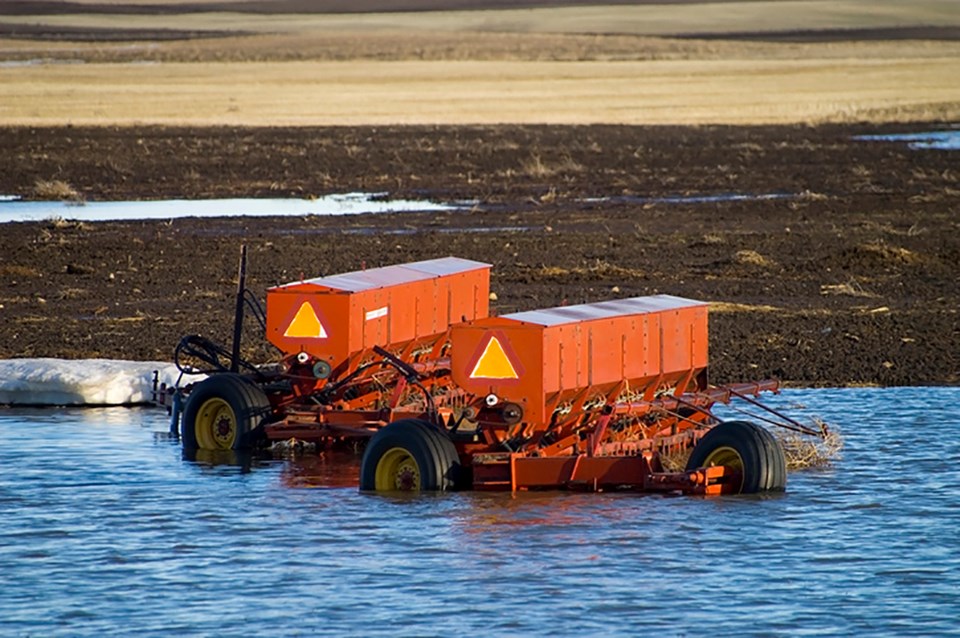NORTHEASTERN SASKATCHEWAN CROP REGION —Very little seeding has occurred in the Northeastern Saskatchewan crop region due to excessively wet field conditions, one per cent of the 2022 crop has been seeded in the region this is behind the five-year average (2017-2021) of six per cent. The crops that have been seeded so far are mostly wheat and pulses such as field peas.
There were good amounts of rainfall reported across the region this past week, causing further delays to field work being conducted. The Nipawin area received 44 mm, the Garrick area 37 mm, the Lake Lenore and Melfort areas 24 mm and the Hudson Bay area 16 mm. This precipitation will continue the recharge of dugouts and other water bodies and help ensure cattle have adequate water supplies as we move into the summer.
Pastures have been slow to green up in the region and cattle producers hope to have the rest of their cattle out grazing soon. Topsoil moisture conditions this week are rated as 15 per cent surplus, 84 per cent adequate and two per cent short. Hay and pasture levels were rated as seven per cent surplus, 89 per cent adequate and four per cent short.
Most producers are still waiting for snow to melt or fields to dry. General field work is estimated to be a week away.
Provincial overview: Slower than average
Seeding progress is still slower than average but more producers were able to get out over the past week. Provincially, 14 per cent of crops are now seeded, up from one per cent last week and behind the five-year average (2017-2021) of 23 per cent. Crops that were seeded over the past two weeks should be emerging if moisture conditions are favourable. In areas of the southwest and west-central regions where conditions are very dry, germination could be uneven.
The southwest region has 34 per cent of their crop seeded, followed by 20 per cent in the west-central, seven per cent in the southeast, five per cent in the northwest, three per cent in the east-central and one per cent in the northeast. Many fields in the eastern half of the province are still too wet to allow producers to seed, full-scale seeding is still a week away in some parts of the province.
Various amounts of precipitation were received across the province; this rain is needed badly in some areas that are too dry for proper germination. However, it will likely lead to longer delays in areas of the eastern regions where moisture is already high. The most rain reported was in the Pelly area with 49 mm, followed by 46 mm in the Bienfait area. The Shaunavon area received 26 mm and the Hazenmore area received 18 mm, which is good to see in the southwest since much of the crop is already in the ground and moisture has been limited in the region.
Due to widespread precipitation across the province, topsoil moisture has slightly improved from last week's report. Cropland topsoil moisture is rated as six per cent surplus, 58 per cent adequate, 26 per cent short and 10 per cent very short. Hay and pastureland moisture is rated as two per cent surplus, 56 per cent adequate, 29 per cent short and 13 per cent very short. This increase in moisture will help pastures grow rapidly.
Many livestock producers have reported that the recent rain helped fill their dugouts and they feel confident that, for the time-being, water quality shouldn't be an issue. However, producers in the southwest and west-central have concerns about water levels and are making plans to haul water if conditions do not improve. Heavy rains throughout the summer will be needed to ensure that water availability does not become a widespread concern.
Producers continue working in their fields seeding, harrowing, rock-picking and rolling. When the weather allows, producers are spraying and seeding. Producers are reminded to be safe during their field activities and when transporting equipment across or alongside roadways. When working in extremely dry areas, especially pastures, ensure sparks or any other fire starter is controlled and a water source is available.





